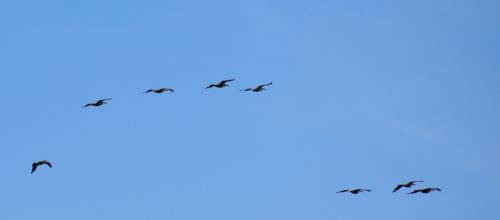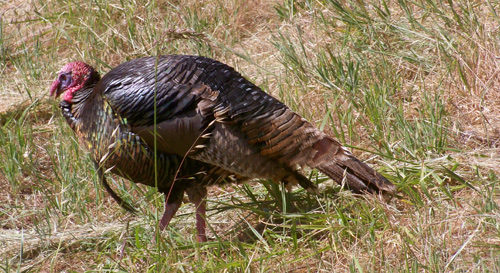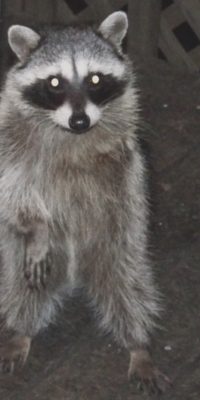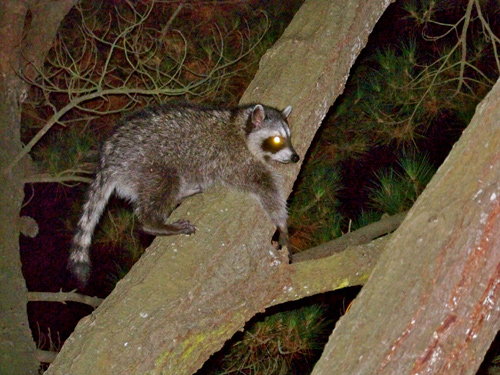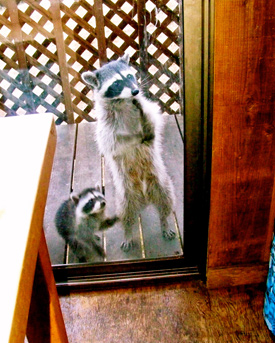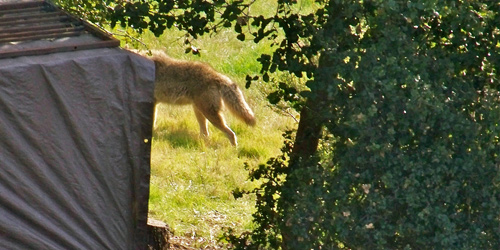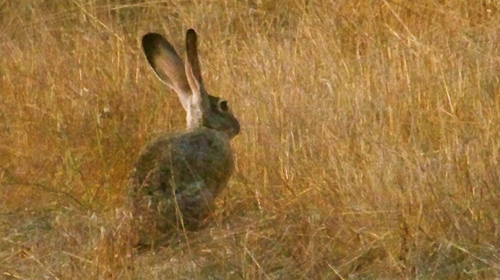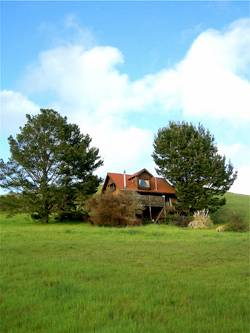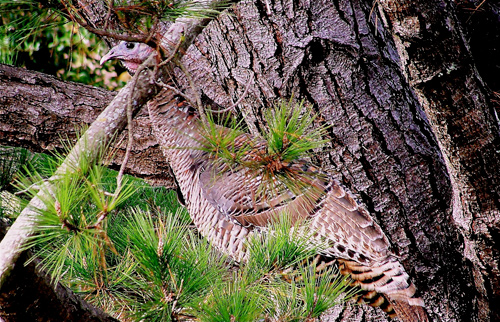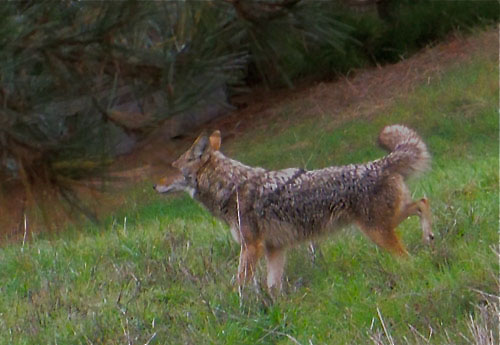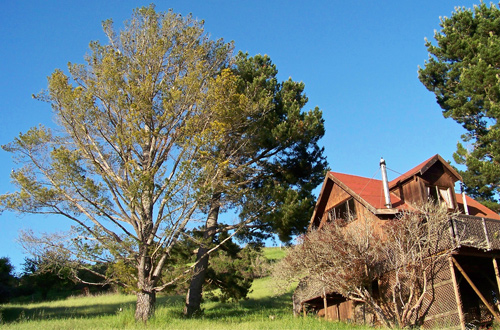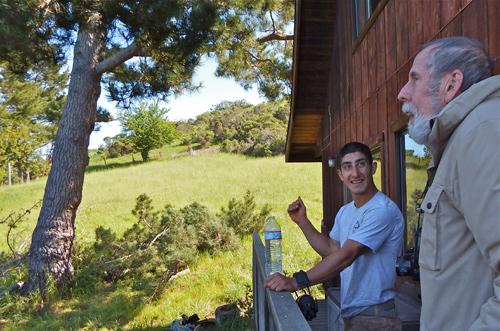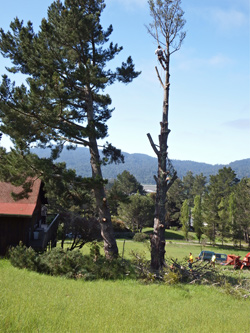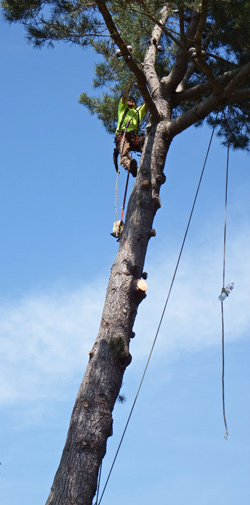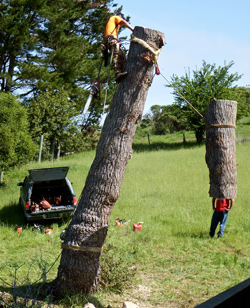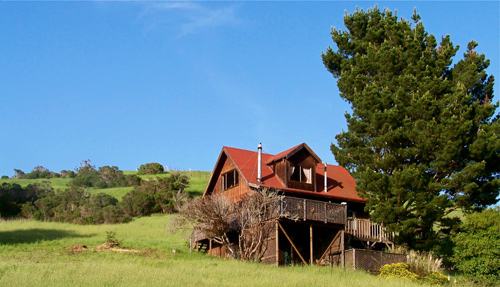Entries tagged with “wild turkey”.
Did you find what you wanted?
Mon 22 Jun 2020
Posted by DavidMitchell under History, Point Reyes Station, West Marin nature, Wildlife
Comments Off on Some good news
Caveat lectorem: When readers submit comments, they are asked if they want to receive an email alert with a link to new postings on this blog. A number of people have said they do. Thank you. The link is created the moment a posting goes online. Readers who find their way here through that link can see an updated version by simply clicking on the headline above the posting.

The rainbow-striped LGBTQ pride flag was created in 1978, and three years ago in Philadelphia, a black stripe and a brown stripe were added. The flag initially symbolized support for lesbian, gay, bisexual, transgender, and queer people, who are often discriminated against. The black stripe and the brown stripe were added to explicitly support brown and black LGBTQ people.

Three weeks ago, our board of supervisors voted to fly the Philadelphia flag at county buildings throughout Marin during national Pride Month, which is June. I first saw it last week flying in front of the firehouse and sheriff’s substation in Point Reyes Station. Few other people seem to have noticed; today while I was doing my “essential business” at the Palace Market, the post office, the gas station, and the pharmacy, I didn’t encounter anyone who was aware of the flag flying in town. (Photo by Lynn Axelrod Mitchell)

A flock of Brown Pelicans over Mitchell cabin Sunday evening, probably headed for Drakes Estero.

A family of quail in our field Sunday. Perhaps because quail once had a reputation for being particularly amorous, “quail” in times past also was a word for “harlot.” In “Troilus and Cressida,” for example, Shakespeare wrote that Agamemnon is “an honest fellow and one who loves quails.”

A female wild turkey landed on the railing of our deck Friday to partake of seeds we’d scattered there for other, smaller birds.

It would be hard to imagine an uglier neck than a wild turkey’s, unless you’re another wild turkey. “When the male turkey gets to courting the hens,” the Audubon Society reports, “extra blood rushes in, and the wattle glows bright scarlet for maximum visual impact.”
The wattle consists of a “wrinkly mass of bumpy, warty-looking red skin,” Audubon notes. “On a hot day, with the sun bearing down, the bare skin of neck and wattle helps release excess heat. Birds don’t sweat.”
Tue 27 Dec 2016

When I drove up to Mitchell cabin last Wednesday, nine blacktail deer were grazing in the front meadow.
It’s common to have deer in my fields. Nine was the most in recent months although in times past I’ve had as many as 16.

Jackrabbits are also more abundant at present than they’ve been for a while.
The rabbits appear fairly comfortable around the deer, and it’s not uncommon to see them grazing side by side.
Unfortunately, cars and trucks take a toll on both the deer and the rabbit populations, so please keep an eye out for them when driving, especially at night. (Photo by Lynn Axelrod)

The rain we’ve been having in Point Reyes Station certainly enhances the scenery.
Here a tea rose on our deck sparkles with droplets after a wet morning. (Photo by Lynn Axelrod)

Horses grazing next to Mitchell cabin don’t seem to mind chilly weather, but on truly cold days, the folks at Point Reyes Arabians outfit them all with horse blankets.

Having escaped another yuletide feast, a wild turkey takes a leisurely stroll beside the cabin.
Perhaps the most emotionally compelling critter around Mitchell cabin this yuletide has been a young, three-legged raccoon that started showing up here in November. My partner Lynn was concerned about the little guy and soon named the raccoon “Peanut” because it was the runt of the litter. Maybe it hadn’t been getting enough to eat. We don’t know how Peanut lost his front-left leg. Perhaps in a fight with another raccoon. When we first noticed him, all that was left of the leg was a bloody spot.

By now the injury has healed over, and Peanut manages to get around fairly well with only three legs. He’s able to climb trees and even the lattice along our deck.
The name Peanut, however, periodically makes me chuckle. As it happens, back in the 1980s, I was part of a group that studied Spanish one evening a week in the old Dance Palace. Meeting at the same time elsewhere in the building were Mexican immigrants learning English.
Once when two of the instructors were to be away for a week, they arranged for the Spanish-speaking students to teach us English-speaking students Spanish and vice versa.
The approach was fairly straight forward. A Spanish-speaking student who was already fairly fluent in English would tell one of us the meaning of a Spanish word and then have the student use it in a sentence. When it was my turn, the woman conducting the class gave me the word cacahuetes, and I was immediately flustered when heard her say it meant “penis.”
I could pronounce ka-ka-wah-tays, but that wasn’t the problem. I now had to use the word in a Spanish sentence without embarrassing myself in front of the class. Then it struck me. The Marin Community Foundation had just awarded a $5,000 grant to a Stinson Beach filmmaker who was producing a physiological study titled Dick. “A Stinson Beach man is making a movie about cacahuetes,” I said in Spanish. The teacher looked surprised but quickly moved on.
When I got home from class that night, I told my then-wife Cynthia, “You’ll never guess what word they taught us tonight…. cacahuetes. Cynthia, who spoke Spanish fairly well, looked puzzled and asked, “What’s unusual about peanuts?”
Happy New Year!
Tue 11 Nov 2014
Marin County, and especially West Marin, have come to seem like a coastal refuge after last week’s Congressional elections, the conundrum of ISIS, California’s drought, and Stanford’s losing to Michigan State in the Rose Bowl.
In order to provide a respite from this world of troubles, I’m presenting this week a collection of happier scenes from around Marin.

St. Mary’s Catholic Church on Nicasio Square. Using locally milled redwood, townspeople in 1867 built the church for $3,000 (about $48,000 in today’s money).
I spent some time in Nicasio late last month, attending the opening of the new Nicasio Historical Society Museum and MALT Day at Nicasio Valley Farm’s Pumpkin Patch. While walking around the square, I was again struck by how unexpectedly well the New England architecture of several buildings fits with the old-west architecture of others, such as the Druid’s Hall and Rancho Nicasio.

Rob Roth on sax, KC Filson on piano, Pierre Archain on bass, and Michael Aragon on drums at the No Name bar in Sausalito. At far right, prominent Sausalito artist Steve Sara sketches the scene.
Last Friday evening, Lynn and I again ended up at the No Name bar, where we often go on Fridays. That’s the night the Michael Aragon Quartet performs modern jazz, much of it in the vein of John Coltrane and Cannonball Adderley.
When the quartet performed Adderley’s Mercy, Mercy, Mercy a month ago, they inspired me to see what I could find out about the late sax player (1928-75). Perhaps the most-intriguing trivia I turned up was the origin of his name.
Here’s the story. Julian Edwin “Cannonball” Adderley, a hefty man, already had a voracious appetite by the time he reached high school, and this led his classmates to call him “Cannibal.” The distinction between cannibals and cannonballs is, of course, so minor that most of the public didn’t notice when Adderley evolved from one into the other. __________________________________________________________________

The view out our bedroom window Sunday of a horse from Point Reyes Arabians grazing in the neighboring pasture.
_____________________________________________________________________

Doe, a deer, a blacktail deer. Ray, a drop of golden sun…. A young deer in a spot of sunlight outside our kitchen window last week pricked up her ears as if the hills were alive with the sound of…. ?

Wild turkeys and deer coexist surprisingly well at Mitchell cabin. Obviously neither looks threatening to the other. The biggest dangers to them come from cars and hunters.

In the pine tree, the mighty pine tree, the raccoon sleeps tonight. In the pine tree, the quiet pine tree, the raccoon sleeps tonight. Wimoweh, wimoweh, wimoweh, wimoweh…. ________________________________________________________________
 A mother raccoon and her kit at our kitchen door.
A mother raccoon and her kit at our kitchen door.
Young raccoons are recognizable by the time we get to see them notwithstanding their having been delivered in kit form.
___________________________________________________________

Lynn and I hear coyotes around the cabin every few days, but we seldom get to see them. Here a coyote takes cover behind our woodshed.

The sloe-eyed coyote emerges from behind a clump of, appropriately enough, coyote brush. Coyotes are close relatives of gray foxes.

Keeping an eye out (and ears up) for coyotes and other predators, a jackrabbit sits in the field outside our kitchen window.

Among the other predators around here are bobcats. They don’t try to stay out of sight, but they trot off when they see humans.

And then there are the gray foxes. They live and breed on this hill, and until recently would show up at the kitchen door most evenings hoping to be fed just about anything: bread, nuts, dog food, whatever.
The foxes still show up occasionally in the afternoon to sun themselves atop the picnic table on our deck. Their nighttime visits, however, have come to an end for now, and I miss their vulpine partying.
Tags: blacktail deer, coyote, FC Filson, gray fox, jackrabbit, Michael Aragon, No Name Bar, PÃerre Archain, raccoon, Rob Roth, St. Mary's of Nicasio, Steve Sara, wild turkey
Mon 14 Apr 2014
Posted by DavidMitchell under West Marin nature
[2] Comments

For years, this was my view of Mitchell cabin as I drove up my driveway.
The cabin was framed by a large Monterey pine on the right and two others on the left.
It was an ideal setting for a cabin, I’d always thought.
My former wife Cathy and I built the cabin in the winter of 1976-77, and we planted the pines soon after moving in.
_____________________________________________________________
 The pines on the west side of the house have long been perches for all manner of birds and have provided refugee for many four-footed creatures, as well.
The pines on the west side of the house have long been perches for all manner of birds and have provided refugee for many four-footed creatures, as well.
They’ve also been people-friendly. A year ago they inspired my stepdaughter Shaili (left), who was visiting from Minnesota, to try her hand at climbing.
________________________________________________________________

The only chipmunk I’ve ever seen around Mitchell cabin showed up one summer morning at the base of one of the pines. _________________________________________________________________

Wild turkeys have become accustomed to using the pines for lookout posts.________________________________________________________________

Here a bashful possum peeks around one of the pines. _________________________________________________________________

And here a coyote prowls underneath the same trees. ________________________________________________________________

Tragically, this stand of pines became doomed. The nearer tree died in the drought, and the further tree had begun to lean precipitously over the cabin. With great reluctance, I called Nick Whitney’s Pacific Slope tree service to cut the pines down and haul away any sad reminders of them. ________________________________________________________________

The pines had become so much a part of my home that I remembered how I felt when I had to take a sick, old dog to the vet to be put down. But there was no avoiding it, and Monday morning, the Pacific Slope crew showed up and got right to work. Here climber Ignacio Franco (left) listens to my lament. (Photo by Lynn Axelrod) ______________________________________________________________
 Despite the sadness of the occasion, Lynn and I were fascinated by the almost-gymnastic feats of Ignacio (seen here) and his brother José as they climbed the trees. (Photo by Lynn Axelrod)
Despite the sadness of the occasion, Lynn and I were fascinated by the almost-gymnastic feats of Ignacio (seen here) and his brother José as they climbed the trees. (Photo by Lynn Axelrod)
________________________________________________________________

A large limb comes floating down after Ignacio cuts it loose with a chainsaw. (Photo by Lynn Axelrod) ________________________________________________________________
 The limbs, pine needles, and cones were ground up in the orange chipper at right and then hauled away.
The limbs, pine needles, and cones were ground up in the orange chipper at right and then hauled away.
Here José Luis Franco, better known as Pepe, (in light-colored shirt) feeds the chipper while David Antonio Lopez (in yellow shirt) drags limbs over.
Ignacio, meanwhile, prepares to cut the top off the dead tree. (Photo by Lynn Axelrod)
_____________________________________________________________
 Pepe cuts a large limb off the top of the leaning pine. (Photo by Lynn Axelrod)
Pepe cuts a large limb off the top of the leaning pine. (Photo by Lynn Axelrod)
_______________________________________________________________
 A man can work up a thirst climbing to the top of a tree and then sawing off heavy limbs, so Pepe took a moment for a drink of water.
A man can work up a thirst climbing to the top of a tree and then sawing off heavy limbs, so Pepe took a moment for a drink of water.
Hoisting the bottle from ground level was his brother Ignacio, who used a block and tackle already in place for lowering cut limbs. (Photo by Lynn Axelrod)
_____________________________________________________________

Ignacio (left) uses a pulley to lower part of a limb that Pepe has cut while David drags off another. The limbs were too close to the house to be simply dropped. (Photo by Lynn Axelrod) ________________________________________________________________

As Pepe descends at the end of the day, these skeletons were all that remained of what had once been a familiar stand of Monterey pines. Tomorrow morning, the Pacific Slope crew will be back, and these too will disappear. (Photo by Lynn Axelrod) _______________________________________________________________
 Late-breaking news: Pepe, Ignacio, and David returned Tuesday as scheduled and finished their logging.
Late-breaking news: Pepe, Ignacio, and David returned Tuesday as scheduled and finished their logging.
Here Pepe appears to be dropping a section of trunk on David’s head, but David is tough, and the impact didn’t faze him. Perhaps because he was actually standing a safe distance away. (Photo by Lynn Axelrod) ________________________________________________________________

Mitchell cabin has survived, but to my eye, its west side now looks starkly naked. For the sake of decency, Lynn and I will soon adorn it with something floral, but for the moment we’re just pining for a couple of old friends.


